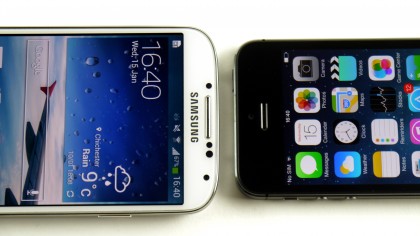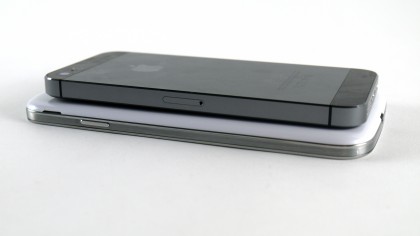Samsung Galaxy S4 vs iPhone 5S
In the clash of the titans, which is the one for you?
Whilst those looking or serious mobile gaming devices might assume the Galaxy S4 is the better choice, they shouldn't completely write off the iPhone, as even the smaller screen size doesn't spoil the fact it's excellent at graphical reproduction.

OS
The fight between Android and iOS is one that has been raging for a while, and is likely to continue for a long time into the future.
Android is an open source OS, allowing users to customise to their hearts content. Don't like the keyboard? Download a new one. Don't like the home screen? Download a new one. Don't like the messaging app? Yes, you've got it, download a new one.
- Still not sure, check out our Android Jelly Bean and iOS7 reviews
Widgets also play an important part of the Android experience, allowing users to get a quick dose of information without having to load up individual apps. Fancy weather clocks, email, text, and social media widgets are now populating the Play Store.
Navigation is done on screen, as well as through the two soft keys that sit either side. This aids the on-screen navigation, although at times makes the whole experience seem a little more convoluted.
iOS is far more locked down, opting for a simpler icon experience. This means that iOS is easy to grasp right from the start, with navigation between screens and settings all done on screen. The only physical navigation button is the home button.
Apple has also thrown in a Control Center, allowing you to control settings like screen brightness, Wi-Fi, Bluetooth and the torch with a simple swipe up from the base. This is very similar to Samsung's quick toggles that live in the notification bar, but is arguably more useful in some cases (well, just the torch really, but it's still a crucial part).
Sign up for breaking news, reviews, opinion, top tech deals, and more.

Performance
One of the biggest selling points of the iPhone 5S has to be the 64-bit A7 chip that Apple has included. It stole all the headlines at the launch of the 5S, and has sparked many a debate amongst mobile enthusiasts.
In the Galaxy S4, Samsung has included Qualcomm's quad-core 1.9GHz Snapdragon 600 chip, backed up with twice as much RAM as the iPhone, coming with 2GB.
When using the Galaxy S4 and the iPhone 5S side by side, there is little to choose between the two. We found that both devices booted up in a very similar time frame, and moving between screens was also slick and smooth.
Loading up apps such as the Calendar/S Planner, Phone and Messaging app were also done almost simultaneously. There did seem to be a more noticeable gap in loading larger apps, with the iPhone loading Youtube a little faster and leaving the Galaxy S4 standing when loading Sonic Dash, so it's worth noting that if you're after a more stable app experience.

Camera
If you're buying a new mobile, the camera is also likely to play a very important role. Whilst not able to entirely replace compact cameras, modern smartphones can produce some spectacular images and are always to hand.
Samsung has fitted the Galaxy S4 with a 13MP sensor, whilst Apple has fitted an 8MP sensor to the iPhone 5S. One word of warning though, we found that the Galaxy S4 defaulted to 16:9 photography meaning that the pictures captured were only 9.6MP, rather than the full 13MP captured in 4:3.
This has some advantages. The majority of mobile screens are now 16:9, as are the televisions and monitors that grace our living rooms and offices.
With mobile photos generally ending up on PCs and social media sites, this ratio would seem more appropriate to those looking to share their images, rather than those looking to create the perfect composition.